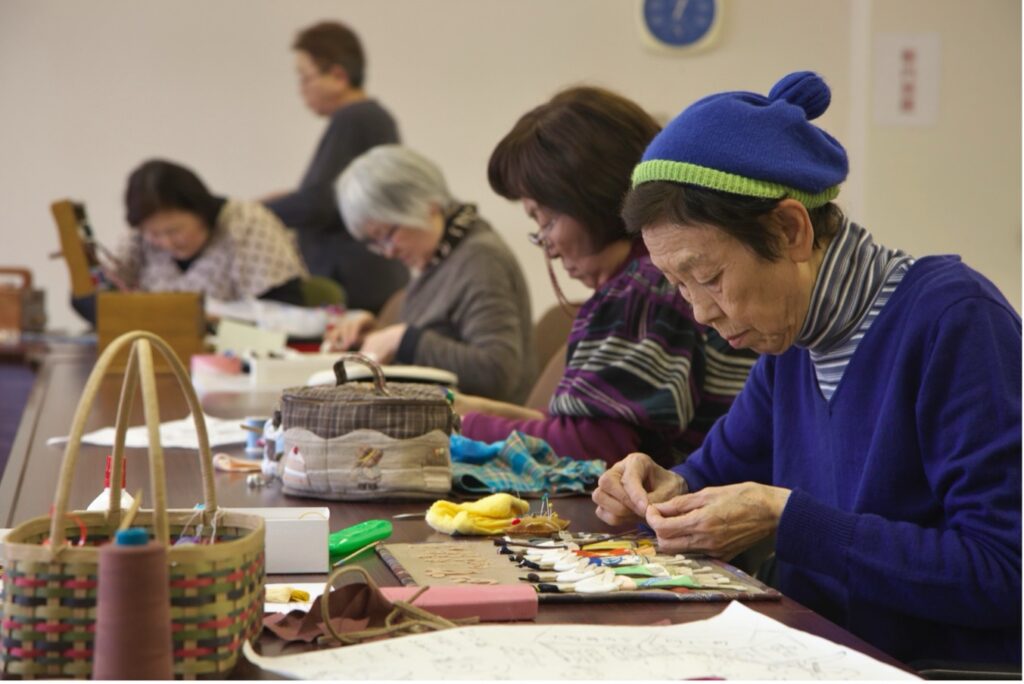To sew, you touch the cloth, cut it with scissors, pass the thread through the needle’s eye, and pull the tail of the thread through the cloth, like a snake. All around the sewing bee, people are busy, chattering.
As I traveled around to various places for exhibitions, everywhere I went I encountered new places, new people. My project was to sew these people’s stories into craft objects.
A lot of people told me their personal stories, and I would make sketches based on them. I made those sketches into patterns, and then the person who told me the story would create a placemat using the pattern. Some people weren’t able to do that, but I would find someone else to help them. Now I have gathered all the mats together in a row, on a single table, to make a long, long table runner of stories. To date, I have gathered 230 of these mats, telling stores from Aniai and Akita City in Akita Prefecture, from Aomori City, from the far end of the Noto Peninsula in Ishikawa Prefecture, from Tasmania, from Jarvenpaa in Finland, and from Oshima Seisho-en in the Inland Sea.
I started the project around 2014. I was working on a different project, “Lodge the Art Museum”, setting up boat-related works in a mountain hut, and I had the opportunity to work on Mt. Moriyoshi, in northern Akita. That is when I visited the village of Aniai. I was so tired, and as I started eating my supper, this image came to me: How cool would it be to have an exhibition on tables instead of walls? After we came down from the snowy mountains, the women shuttled valiantly between kitchen and table, easing our fatigue with warm and delicious foods.
They regaled us with stories of their families and the things that happened around them. They were not talking about the kinds of things you would read in a newspaper, or the history of their village, or its ceremonies and customs. They were telling stories that were modest, refreshing, surprising, from their own daily lives. Things they didn’t usually tell anyone, some very bitter and sad, some trivial, some so painful you couldn’t help but laugh.
These were stories, and storytellers’ memories are selective. Some details were highlighted while others were omitted, all rendered anew in the retelling. I had no interest in knowing whether the stories are true or false. I also had no interest in recording memories for posterity. My interest lay solely in the act of “telling,” the ephemeral story that appears before your eyes and then disappears once more, with the storyteller’s breath, in that instant. Why? Because that is where I can see the vital but hidden “art” of the animals we call humans, an art that perhaps no one has ever paid attention to before.
I listen to people’s stories and let them run through my imagination. I check the details with them, and sometimes things are not completely clear, so I have to fudge a little, but then I make my sketches. Everybody brings their lunch and gathers around the table, and they teach one another how to sew based on those sketches. They exchange materials, and for those who cannot sew we find people to help them. Some people choose to take their projects home and do them on their own there, and that too is important. The end result is sewing projects that embody a wide range of emotions, turned into “living things” before our eyes.
The final table runner has a kind of autonomous strength that can only be found in crafts, not in paintings or photographs. This is an elemental strength that destroys and transcends the complex structure of language. Crafts have a certain immature, destructive power that is familiar to children, doing things once and only once, who cannot think of anything beyond living in this present moment. It is a kind of strength that is antithetical to those who have learned and refined specific skills.
Tomoko Konoike


